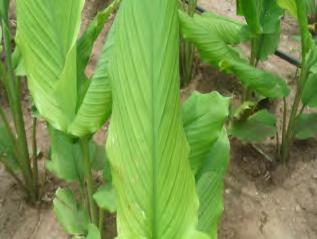1)IISR Varada:
Other States Variety
1)Green Ginger variety: Rio-De-Janerio, china, Varadha.
2)Dry Ginger varieties: Maran, Nadia.
Soil –
Climate-
Time of sowing
Sowing is done by first week of May- June.
Seed Rate
Seed treatment
Spacing
keep plant distance of 15-20 cm between the row and 30 cm between two plant.
Sowing Depth
Depth should be near about 3-4 cm.
Method of sowing
Direct sowing also transplanting method is used for planting.
Fertilizer Requirement (kg/acre)
| UREA | SSP | MURIATE OF POTASH |
| 55 | 60 | 16 |
Nutrient Requirement (kg/acre)
| NITROGEN | PHOSPHORUS | POTASH |
| 25 | 10 | 10 |
1.Rhizome scale : Aspidiella hartii

| Symptoms of damage: | |
| |
| Management: |
|
2) Shoot borer : Conogethes punctiferalis


| Symptoms of damage: | |
| |
Management:
3.Leaf roller: Udaspes folus


Symptoms of damage:
|
Management:
4.Thrips: Panchaetothrips indicus

Symptoms of damage:
|
Management:
Spray insecticides like quinalphos 0.025% or phosalone 0.07%
1.Nitrogen
|
| Deficiency Symptoms |
Yellowing of older leaves; size of the leaf become small; stunted plant growth |
| Correction Measure |
Foliar spray of urea@1.0% |
2.Potassium
|
| Deficiency Symptoms |
Marginal chlorosis occur older leaves |
| Correction Measure |
Foliar spray of KCl@1.0% |
3.Iron
|
| Deficiency Symptoms |
Chlorosis occur in young leaves |
| Correction Measure |
Foliar spray of FeSO4@0.5 |
1.Soft rot or rhizome rot : Pythium aphanidermatum/ P. vexans / P. myriotylum
| |
| |
Management
2) Bacterial wilt : Ralstonia solanacearum

Symptoms
Management
3) Blight and leaf spots: Phyllosticta zingiberi

Symptoms
|
Management
In 8months crop is ready for harvesting. For fresh spice purpose, ginger is harvested from 6th month and if it is to be used for processing, then it is harvested after 8 months. Right time for harvesting of ginger is when leaves gets yellow and dry out completely. Remove rhizomes by dugging and after harvesting clean rhizomes by thoroughly washing in water for 2 to 3 times. Then dry them in shades for 2-3days.
For dry ginger purpose, only the outer skin is to be peeled and then dried in the sun for a week. Outer skin is removed with help of special knife or split bamboos with pointed end. Yield of dry ginger is about 16-25% of green ginger.
Storage: Fresh, disease free rhizomes are selected then treated with solution of Carbendazim + Mancozeb@40 gm/10 ltr of water for 30 min. It will prevent rotting of rhizome in storage. Then dry the rhizomes in shade. Store dried rhizome in pit of convenient size, covered with plank having 2-3 holes for aeration. Before storing rhizomes in pit, spread 1 inch thickness sand layers.
12 – 15 t/ha.
